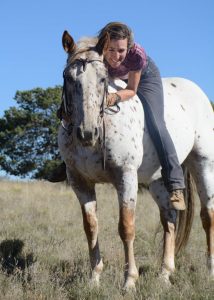 Editor’s Note: Best Horse Practices Summit presenter Katrin Silva grew up riding dressage in Germany before moving to the United States at age 19 to learn to ride Western. She’s been riding both disciplines for the last twenty years and is a regular guest columnist for Cayuse Communications. She lives in New Mexico where she works with dressage and Western clients. Visit her blog here.
Editor’s Note: Best Horse Practices Summit presenter Katrin Silva grew up riding dressage in Germany before moving to the United States at age 19 to learn to ride Western. She’s been riding both disciplines for the last twenty years and is a regular guest columnist for Cayuse Communications. She lives in New Mexico where she works with dressage and Western clients. Visit her blog here.
Buy her book, Dressage for All of Us here.
By Katrin Silva
Author Derrick Jensen wrote: I saw a stop sign, and it occurred to me that just as no one expects a stop sign to stop a car, I shouldn’t expect words to substitute for experience. That’s not their job . . . The job of words is to direct us toward experience, to round out experience, to facilitate experience, and to give us ways to share at least a pale shadow of that experience with those we love.
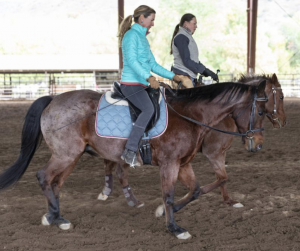
Katrin Silva and Amy Skinner present at the BHP Summit
In my world, I hear:
“Keep your hands still!”
“Keep your heels down!”
“Don’t pull on that inside rein!”
“Put him on the bit!”
These are all phrases I’ve heard over and over during lessons and clinics. Instructors – myself included – use them all the time. Most of us can’t imagine giving or taking riding lessons without them. And yet, these words, in spite of the good intentions behind them, rarely have the desired effect.
In theory, teaching people how to ride is a simple process: instructors dispense information, which riders translate into practice. A teacher’s words cause students to do things a certain way, which makes their horses respond a certain way, which in turn leads riders to experience and feel correct movements and transitions.
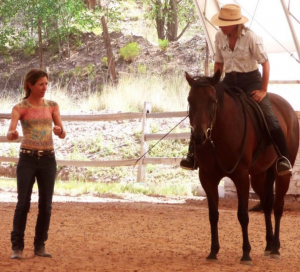 In real life, this hardly ever works. Riding lessons follow a different script:
In real life, this hardly ever works. Riding lessons follow a different script:
- Teacher tells her student to do something.
- Student tries to do what she is told, but it does not look that way to the teacher.
- Teacher repeats her words, sometimes in a louder voice.
- Student tries harder to do as she is told. Her shoulders tense, her jaw clenches.
- Horse under her begins to worry about what is going on.
- Horse’s back stops swinging.
- Horse stops chewing on the bit.
- Horse and rider become more and more tense.
- Teacher becomes more tense.
Lesson ends with all parties feeling frustrated.
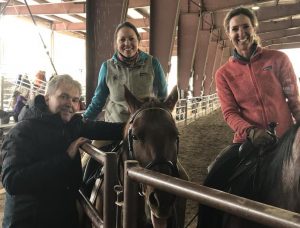
Silva and Skinner with Dr. Gerd Heuschmann
This does not happen because trainers don’t try to teach well or because students don’t try to learn. Things happen. There are disinterested or verbally abusive teachers out there, just as there are students who take lessons for the wrong reasons (so they say they’ve “worked with” Dressage Guru X, for example).
Yet there are also knowledgeable, well-meaning instructors and motivated students with realistic goals. So why is teaching and learning to ride better still difficult?
The answer has its roots in the nature of language:
- Meanings of words are not set in stone.
- Words mean different things to different people.
- Meanings change over time.
All nouns, verbs, and adjectives have denotations and connotations, giving them positive, neutral, or negative tones. A rider’s background and experience play a role in her understanding of words and expressions. “Contact” means something desirable to a dressage rider, while it sounds like pulling on the horse’s mouth to most Western riders.
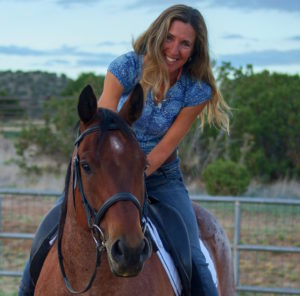 Over the last 30 years, my understanding of “on the bit” has evolved from positioning a horse’s nose near the vertical no matter how, to a feeling of controlled power that involves a horse’s entire body, along with his mind.
Over the last 30 years, my understanding of “on the bit” has evolved from positioning a horse’s nose near the vertical no matter how, to a feeling of controlled power that involves a horse’s entire body, along with his mind.
I think of a horse’s “suppleness” as pasta al dente, while I used to think of it as overcooked.
Most of us, with enough time and effort, can learn to sit on a horse in a position that looks halfway correct and use cues our horse responds to. But we still aren’t learning about feel and timing. We don’t learn about the wisdom to know when to do what, or when to quit doing it.
What’s a teacher to do?
What’s a student to do?
Should we just give up on formal instruction altogether?
As riders, should we wait for a good seat and an effective system of communication to evolve naturally, without feedback, without guidance?
As teachers, should we quit trying to explain things and instead give our students mysterious clues, like “you just have to feel it”?
I think we need to keep teaching and learning, of course. But we need to change our understanding of both.
Good teachers know their stuff, but they don’t throw all available information at their students at once. Even if they see multiple things to improve, they choose their words wisely, focusing on one issue at a time.
Good teachers see more than a rider’s alignment of ear, shoulder, hip, and heels. They’re aware of a student’s riding experience, her level of anxiety, her level of fitness. They’re aware of the type of horse she is riding. They’re aware of her relationship with that horse. All of these factors influence what a good teacher tells her student.
Good teachers are sensitive. They encourage questions. When a student looks or acts confused, they have alternative ways of explaining the same concept. Good teachers know when to push and when to back off, when to talk and when to shut up. Good teachers assume their students are doing the best they can with the horse they are riding today. Good teachers want to give their students tools to problem-solve, not buttons to push. Good teachers want their students to become independent, thinking riders, not co-dependent marionettes who follow instructions with no sense of purpose.
Good students respect their teachers, but don’t worship them blindly. They know that not every teacher is right for every student, but they don’t jump from teacher to teacher at random intervals, hoping to find the holy grail of good horsemanship in just a couple of lessons or clinics.
Good students are not afraid to ask questions, especially questions starting with “why?
Good students try hard to do what their teacher is asking, but not so hard that it makes them anxious. Good students give feedback to their teacher, like “this was helpful!” or “I don’t know what you mean – can you explain it a different way?”
Good teachers and students know that it’s a two-way process; they learn and teach each other. One of the first trainers I worked for told me: “Those who can, do. Those who can’t, teach.” The implication was that being a good trainer meant you didn’t have to bother with the menial task of teaching. It took me a few years to recognize how wrong she was. Being a good trainer of horses requires the same qualities of kindness, humility, and patience that those same instructors have for their students. We work on refining our use of words just as we refine our use of aids.
Very nicely put, Katrin.
Thank you, Eva! I miss you and Remy. Please give him a hug.
Good article and I think that also tells us as professionals it is so important to first know AND understand the „official“ language and then we all (trainers and students)are able to work with images like noodle, marshmallow and stick.
End of the day it is important to teach correct terminology and I know that you are one of them❤️
Thank you so very much for being the kind of teacher that thinks about how this process, the interplay of experience, understanding, interpretation, and communication, does and does not work. Your students, but human and equine, are much the better for it!